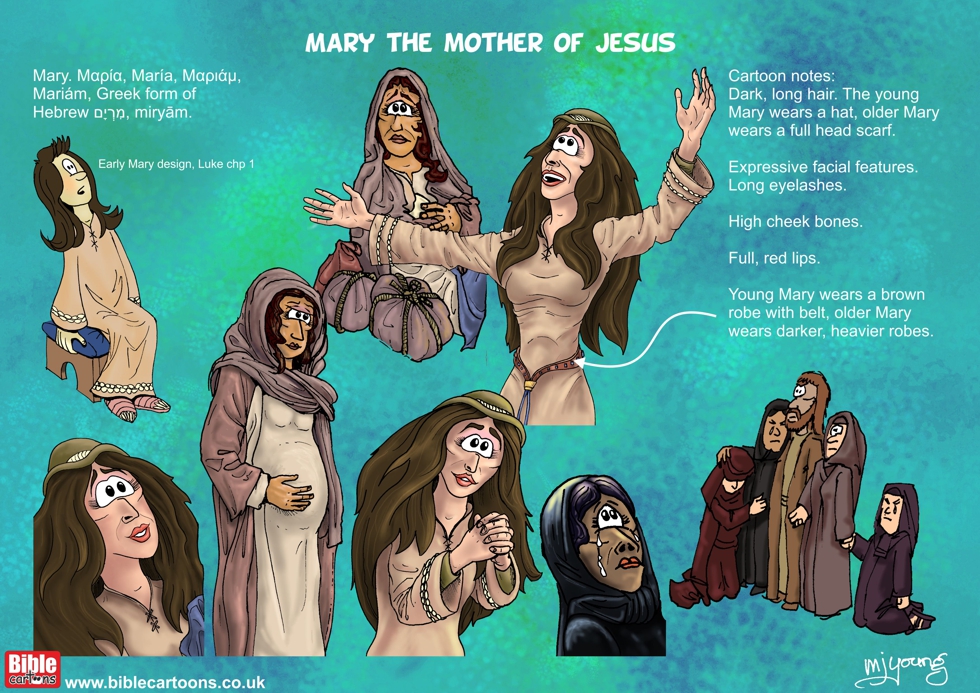
Mary the mother of Jesus character design sheet

This is my character sheet, or design specification, for Mary the mother of Jesus. The purpose of this sheet is to keep a record of the attributes or characteristics of my drawing, so that I can draw a similar-looking cartoon in all future scenes including Mary the mother of Jesus.
I first drew my version of Mary the mother of Jesus in December 2007 in “Luke 02 – Nativity SET01 – Scene 02 – Stable (Wooden version)”, which was only the 5th Bible Cartoon every drawn! That’s very, very early on in the history of Bible Cartoons..
By formalising my ideas on a character design sheet in this way I would have a simple and accessible design reference point, which would remind me of what I had drawn in previous cartoons. By referring to this sheet every time I drew a scene including Mary the mother of Jesus I hoped I would be able to draw and colour her to match previous cartoons, ensuring great similarity and therefore continuity between Bible Cartoons featuring Mary the mother of Jesus, even if these cartoons were drawn months or even years apart.
Without this character sheet to refer to I might very well accidentally draw a scene where the Mary the mother of Jesus character is quite different from previous drawings, which would be a problem if someone views and/or buys several Bible Cartoons and the same person looks quite different in each scene! There is a very real danger of this happening since my abilities and style gradually change and evolve over time, especially as I learn new art techniques and want to incorporate new ideas into my Bible Cartons. By referring to the character sheet I can be confident that I will draw a similar-looking person, even if my artistic skills have undergone change and development over time.
Mary in the New Testament
The Name Mary occurs about 60 times in the New Testament. Collating all these references we have the following apparent identifications:
01) Mary, the mother of Jesus.
02) Mary of Magdala (Mary Magdalene).
03) Mary, the mother of James and Joses, the “other” Mary.
04) Mary, the wife of Clopas.
05) Mary of Bethany.
06) Mary, the mother of John Mark
07) Mary of Rome.
Mary the Mother of Jesus – Personal History
Mary. Μαρία, María, Μαριάμ, Mariám, Greek form of Hebrew מִרְיָם, miryām meaning “obstinacy, rebellion”.
Mary appears in the following passages: the Infancy narratives, Matthew 1 and 2; Luke 1 and 2; the wedding at Cana of Galilee, John 2:1-11; the episode of Matthew 12:46; Mark 3:21, 31ff; the incident at the cross, John 19:25ff; the scene in the upper chamber, Acts 1:14.
Mary in the Infancy Narratives.
Luke tells the story of Mary’s inward and deeply personal experiences: her call (Luke 1:26f), her maidenly fears (Luke 1:29, 35), her loyal submission (Luke 1:38), her outburst of sacred and unselfish joy (Luke 1:39-55). From this anticipatory narrative he passes at once to the Messianic fulfillment.
In contrast, Matthew tells the story of the outward and, so to say, public experiences of Mary which follow hard upon the former and are in such dramatic contrast with them: the shame and suspicion which fell upon her (Matthew 1:18); her bitter humiliation (Matthew 1:19), her ultimate vindication (Matthew 1:20f).
Mary is mentioned only four more times after Jesus’s ministry commenced, which are:
01) The marriage at Cana, which includes his mother Mary’s expectation of his messianic powers (John 2:1-11).
02) At Capernaum, where at a public gathering Mary desires to speak to Jesus, and He seems to refuse to admit any authority on the part of His relatives, or any privilege on account of their relationship (John 2:12; Matthew 12:46-50).
03) At the crucifixion, where Christ, with almost His last words, commends His mother to the care of the disciple whom He loved (John), and from that hour John assures us that he took her into his home (John 19:25-27).
04) After the ascension of Jesus, Mary is engaged in prayer in the upper room in Jerusalem, with other faithful followers of the Lord (Acts 1:14).
Return to BC Encylopaedia Index page
